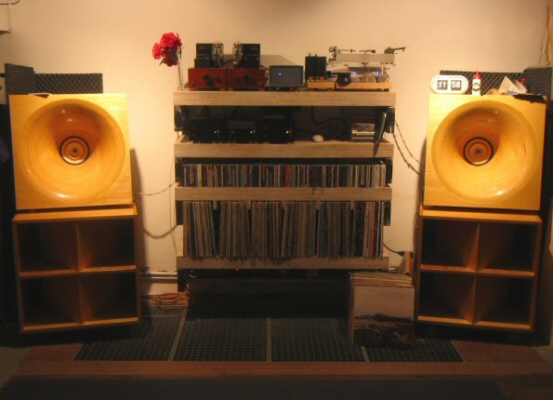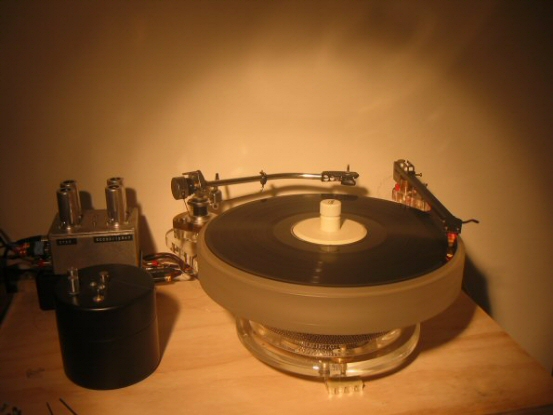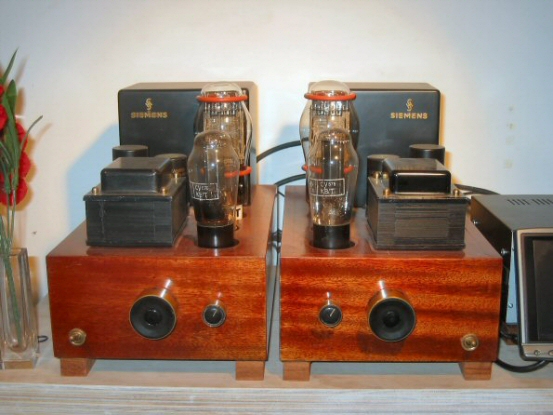Werner Rem, Holland (Updated)
My story starts when I decided to give-up the garage for 2 old Citroën cars on the lower floor of my house to make some space for the kids to play, Below one of the cars was a grease pit and that would be a nice place for a bas-speaker. Besides, ending one hobby makes place for a new. Searching the net for bas-speaker plans, I came across Bert’s article about building his first sub-bas horns, describing how he built them but with enough info to calculate/design a pair for yourself.

Looking at Bert’s site you can not overlook the Oris horns. They would be a nice combination with a sub-bas horn. But a little above budget. I have built quit some speakers in my life and thought it should be possible to make a pair of Oris 200 horns myself. A lot of calculating, drawing and some e-mails to Bert followed. Finally they were made out of Poplar-multiplex layers. Round cut-outs were made with a router in layers of 12 mm (3 diameters in one 12 mm layer). All pieces were glued together and with a piece of sand-paper on a wine bottle the final shape was made . A lot of high gloss varnish gave them their final look (total work time about 50 hours for one horn).
Because of the tight budget I went to Bert’s place for a pair of Fostex 208 Sigma speakers for the horns and a pair of Eminence Kappa 12 inch woofers for the sub-bas. Of course I listened to Bert’s Oris with LaScala Bass and concrete Sub-bas. I never heard something like that, and asked myself if I could ever built something at home that comes close.
The horns with the Fostex drivers mounted sounded already very good, even without bas at all and on an old integrated Pioneer tube amp. Next was the actual rebuilding of the garage and realizing the sub. Opening the floor made clear that there was not the space I thought there should be. Finally I built one sub-horn about 3,2 meter long with a bit more than 1 square meter mouth, giving a lowest frequency of 30 Hz (I had hoped to reach 24 Hz).

The form is made with multiplex in a concrete ‘box’, all not used space is filled with sand, a total of 450 kg. The two drivers made it easy to connect to a stereo amp. Bert already told me that a pair of horns and a sub alone should not be enough due to time-alignment problems so a pair of LaScala bas-horns were made out of the same polar-multiplex, with a pair of Electrovoice 15 inch drivers to complete the system. I am for sure the best client of the woodshop around the corner.
For the time being the ‘Oris’ horns played on the Pioneer tube-amp. The LaScala’s and sub were driven by an old solid state amp with passive filters, but during the process I realized that such an efficient system is a perfect situation for a SET amplifier. A tube phono/preamp and a 6B4G SET amp were built with the best materials/components I could find (one has to fill all evenings, weekends and holydays somehow !). Of course this made a big improvement, especially when Bert calculated a passive line-filter. The 6B4G SET drives the horns and through the filter a 4 channel solid state amp drives the LaScala’s and the sub. By now I started missing the high frequencies (the Fostex don’t go higher than about 15 kHz) and although the Fostex is not a bad driver at all I had the feeling a better driver could make the system sing better. A pair of (second hand) AER BD1 speakers placed in stead of the Fostex made the system at least come a bit close to the sound I heard at Bert’s place.

From time to time I still can not believe that a paper cone can make the sound of a cymbal or a guitar that realistic. The music does not seem to come out of the speakers anymore. It is wider, deeper and more dynamic as any system I ever listened to. I hear details in my record and CD collection I never noticed before.
And for the first time you have the feeling the musicians are standing right in front of you. So thanks Bert for al the questions you answered even for a DIY project with a tight budget (which after all ...) I enjoy the sound every day.
In trying to make a complete article for this showroom I need to say that 2 modifications need to be done to make things even better.
I built the LaScala’s out of 18 mm multiplex, but did not, as in the original make the side-braces. By now I think they need them. When playing loud there is to much movement of the side-panel of my LaScala’s. (Poplar multiplex weights about 40% less than normal multiplex). And the sub needs an active filter of 24 dB/octave. Now it is 12 dB and you hear some of the time-alignment trouble mentioned earlier.

Werner
My set:
- Home built turntable with tube pre/phono amp
- Fanless PC with USB DAC (Doede Douma)
- Home built tube amp
- Chip amp (LaScala)
- HiFonics 4 x 70 watt solid state amp (horn loaded subwoofer)
- All cables (home built interconnect and speaker cable) twisted copper wire with paper/cotton isolation
- Dedicated mains group